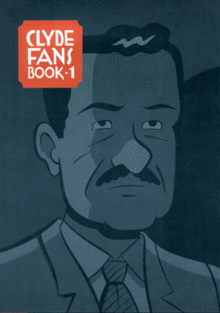Clyde Fans
| Clyde Fans | |
|---|---|
 Cover to Clyde Fans: Book One (Drawn and Quarterly, 2004) | |
| Date | in progress |
| Series | Palookaville |
| Page count | 350 (projected) pages |
| Publisher | Drawn and Quarterly |
| Creative team | |
| Creator | Seth |
| Chronology | |
| Preceded by | George Sprott |
Clyde Fans is an in-progress graphic novel (or "picture novella") by Canadian cartoonist Seth, projected to come to 350 pages when completed.
The story follows two brothers—one outgoing, the other painfully introverted—as they watch their electric fan business go under in the face of competition from the air conditioning industry.
The first instalment of Clyde Fans appeared in the tenth issue of Seth's comic book Palookaville in January 1998, and has continued in each issue since. It has been collected in Clyde Fans: Part One in 2000 and Part Two in 2003. These two volumes were collected in 2004 as Clyde Fans: Book One.
Overview
Clyde Fans is the story of two brothers and their failure keep their family business afloat in the face of changing technology, as well as the two brothers' unsociability, which one brother is able to deal with on the surface, but the other is painfully unable to.[1] The finished book will encompass five parts across two volumes.[2]
Synopsis
Part One of the story opens in 1997 with Abe Matchcard speaking to the reader while puttering around his home, the old Clyde Fans building in Toronto. He tells the story of how he and his brother, Simon, watched their family's electric fan company go out of business in the face of the emerging air conditioning industry, while relating stories of his sales technique and talking about his peculiar brother.[2]
The story then, in Part Two, moves back in time to the 1950s, and focuses on Simon's attempt at a "real life", despite his "inability to cope" with his rôle as salesman,[3] while his more outgoing, natural salesman brother dominates and belittles him.[4] He sets out "on a humiliatingly unsuccessful attempt at opening new sales territory", but is turned down by potential client after potential client due to his introversion and insecure approach. He suffers something of a breakdown, and ends up sitting under a tree in a miniature golf course he had wandered through.[2]
Part Three moves into the 1960s, with Simon's career as salesman over, and Abe struggling to keep the business afloat. Eventually, Abe and Simon struggle with having to put their mother in a nursing home.
Part Four opens in 1975. Abe has to make the difficult decision of having to sign the papers to close shop, a decision he blames on striking workers.[5]
Characters
- Abraham (Abe) Matchcard
- A retired fan salesman, who narrates the story.[6] A "born salesman", who dominates and continually denigrates his shy, reserved brother Simon.[4]
- Simon Matchcard
- Abe's shy, introverted brother. He obsessively collects penny postcards. Seth himself is an obsessive collector of comics and pop culture artifacts, while admitting that he often finds such people "hateful", as they are often "greedy, secretive, rude, [and] socially awkward".[4]
Background
The idea for the Clyde Fans company came from an actual old storefront in Toronto called Clyde Fans. Seth related, "I used to look into window when I walked by because I'm very attracted to this sort of thing. In the dim light of the office you could see on the back wall two photographs of two men, which were probably the owners. I just assumed they were brothers. Over the next couple of years while working on projects I put together a story of what these guy's lives were about although it probably had nothing to do with the reality of their real lives."[2]
Style
The story is drawn in Seth's familiar wobbly, thick-stroked brush cartooning,[7] "deceptively simple and expressive lines, unhurried, exact, and luxurious; shading rich with texture."[3] As in It's a Good Life, If You Don't Weaken, the artwork was done using a two-colour process, with black and white "aerodynamic"[2] linework accented with grey and blue shading[8] on beige-coloured paper.[1] The art is reminiscent of 1930s New Yorker cartoons, giving the work the look of melancholic nostalgia.[2]
Seth attempted to move away from traditional comic book storytelling techniques by slowing down the narrative and making use of silent panels, "giving a story as much length and breathing space as it needs to be told". He said, "panels that aren't necessary to move the story along but are necessary just to create the right mood for what you're doing."[2]
Awards
- (2005) Doug Wright Award for Best Book[9]
See also
References
- 1 2 "CLYDE FANS: Book 1". Publishers Weekly. 2004-05-24. Retrieved 2011-12-30.
- 1 2 3 4 5 6 7 Arnold, Andrew D. (2004-06-02). "A Cool Breeze". Time magazine. Retrieved 2011-12-29.
- 1 2 Howard, David (May 2004). "Clyde Fans: Book One by Seth". Quill & Quire. Retrieved 2011-12-26.
- 1 2 3 Miller, Bryan (June 2004). "An Interview with Seth". Bookslut. Retrieved 2011-12-26.
- ↑ Gardner, Jared (2010-10-24). "X'ed Out, Clyde Fans, & the Rise of the Hardcover Comic Book". The Comics Journal. Retrieved 2011-12-26.
- ↑ Wolk, page 126
- ↑ Wolk, page 132
- ↑ Gatevackes, William (2008-05-20). "Palookaville #19". Pop Matters. Retrieved 2011-12-29. External link in
|publisher=(help) - ↑ "Past Winners". Doug Wright Awards.
Works cited
- Wolk, Douglas. Reading Comics: How Graphic Novels Work and What They Mean. Da Capo Press, 2007. ISBN 978-0-306-81509-6
External links
- Preview of Clyde Fans: Book One at the Drawn and Quarterly website
- "Seth’s Suspension of Perception in Palookaville #19" by Kathleen Dunley at The Comics Grid (April 11, 2011; retrieved 2011-2-12-29)